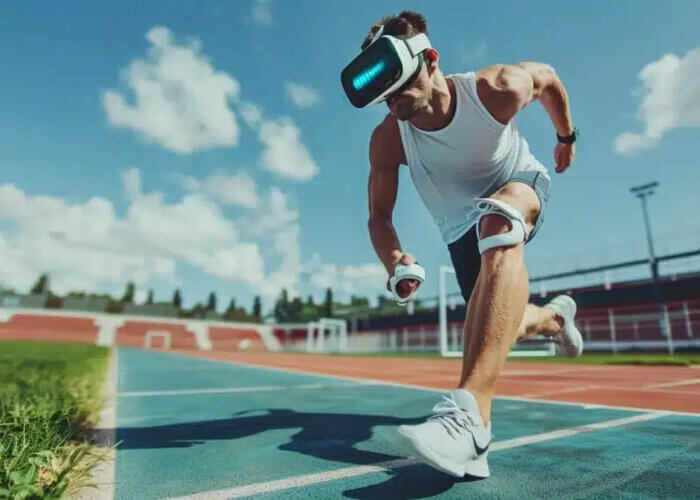In today’s fitness world, smart technology isn’t just a trend—it’s a game-changer. From AI-powered fitness trackers to smart apparel with built-in sensors, wearable fitness tech transforms how we train, recover, and push our limits. These devices go far beyond step counting; they provide real-time performance insights, track biometric data, and offer personalized coaching to maximize results.
Experts say the integration of wearable technology into fitness routines is helping athletes and everyday users optimize their workouts like never before. Whether you want to improve endurance, monitor recovery, or stay motivated, wearable fitness devices offer data-driven solutions to take your performance to the next level. In this guide, we’ll explore the latest innovations in wearable fitness tech and how they shape the future of exercise.
Experts say the integration of wearable technology into fitness routines is helping athletes and everyday users optimize their workouts like never before. Whether you want to improve endurance, monitor recovery, or stay motivated, wearable fitness devices offer data-driven solutions to take your performance to the next level. In this guide, we’ll explore the latest innovations in wearable fitness tech and how they shape the future of exercise.
The Rise of Wearable Fitness Tech
Wearable fitness technology has evolved significantly in recent years. What began as simple pedometers to count steps has now blossomed into a range of advanced devices that offer a detailed analysis of a person’s health and fitness in real-time. From smartwatches and fitness trackers to smart clothing and biometrics, wearable devices are now collecting vast amounts of data and using AI to make sense of it.Key players in the wearable fitness tech market, such as Fitbit, Garmin, Apple, and WHOOP, continually introduce innovative features that empower users to enhance their workouts, monitor their health, and improve recovery. But the potential of these devices goes beyond tracking—it’s about providing actionable insights that help users optimize their training and overall performance.
1. Advanced Performance Metrics and Tracking
One of the main advantages of wearable fitness technology is the ability to collect real-time data on various aspects of physical performance. These devices can monitor everything from basic metrics like steps and heart rate to more advanced data such as muscle activation, lactate threshold, and VO2 max (maximal oxygen uptake). Here’s a breakdown of how these metrics help boost performance:a. Heart Rate and Heart Rate Variability (HRV)
Monitoring heart rate during exercise is essential for tracking intensity and ensuring that users are training in the optimal heart rate zones to achieve specific goals, whether it’s fat loss, endurance, or strength building. Advanced fitness devices can also track Heart Rate Variability (HRV), which is the time variation between each heartbeat. HRV is a key indicator of recovery and overall cardiovascular fitness, with higher variability typically indicating better recovery and resilience to stress.Wearables like WHOOP and Polar are known for offering highly detailed heart rate monitoring, which helps users fine-tune their workouts for maximum results.
b. Real-Time Data Analytics
Wearable devices now have advanced sensors that can measure real-time data, such as cadence, pace, power output, and even form. This data is invaluable for athletes looking to optimize their performance. For example, Garmin watches provide cycling power data that helps users measure the efficiency of their pedal stroke, while running watches from brands like Suunto track pace and running dynamics, such as stride length and cadence, to enhance running form.This real-time feedback allows users to adjust their intensity mid-workout, making their routines more efficient and performance-oriented.
c. Tracking Recovery and Fatigue
Fitness is not just about pushing yourself harder in every workout; recovery is equally important. Wearable devices are helping users understand how well they recover and whether they are pushing their limits too much. WHOOP is known for its comprehensive recovery insights, offering users daily recovery scores based on heart rate variability, sleep quality, and other physiological factors. These insights help users avoid overtraining and optimize their workouts based on their recovery status.Devices like Oura Ring also track sleep quality, ensuring that users can recover adequately, which ultimately leads to improved performance and endurance during workouts.
2. Smart Clothing: The Future of Wearable Fitness Tech
While fitness trackers and smartwatches dominate the wearable fitness space, smart clothing is quickly emerging as an exciting new frontier. Smart clothing integrates sensors directly into the fabric of garments, such as shirts, shorts, or socks, to monitor a range of performance metrics.a. Muscle Activation and Movement Patterns
Smart clothing is designed to track muscle activation during workouts, providing users with detailed insights into their training. For example, Hexoskin, a smart shirt, tracks metrics such as heart rate, respiratory rate, and muscle effort, giving users a comprehensive picture of their performance. This kind of data is particularly beneficial for athletes or individuals performing strength training, as it helps them track the effectiveness of each movement, ensuring they engage the right muscles and avoid injury.b. Breathability and Comfort
Another advantage of smart clothing is its ability to adapt to the body’s needs. These garments often come with integrated sensors that can monitor body temperature, sweat levels, and heart rate, providing data to help users understand how their body is responding to the workout. For example, Athos apparel incorporates real-time muscle activity tracking and biometrics, helping users improve form, reduce fatigue, and optimize their routines.c. Posture and Alignment
Smart clothing can also assist with tracking posture and alignment during exercises such as yoga, pilates, or strength training. This helps users maintain proper form, preventing injuries and improving overall movement efficiency.
3. The Role of Artificial Intelligence (AI) in Wearable Fitness
AI is playing an increasingly important role in wearable fitness devices by turning raw data into actionable insights. As AI algorithms analyze user data, they can provide personalized workout recommendations, recovery strategies, and lifestyle changes tailored to individual needs.a. Personalized Fitness Coaching
AI-powered fitness assistants, like Vi Trainer, provide personalized, real-time coaching during workouts. These assistants can adapt the workout as you go based on real-time data like pace, fatigue, and effort, ensuring that you remain challenged without overexerting yourself. Through machine learning, AI can identify patterns in the data over time and optimize future workout routines, making training more efficient and results-driven.b. Nutrition and Hydration Tracking
AI also helps users manage their nutrition and hydration. Wearables like Nutrionix are integrated with AI to provide personalized meal suggestions and track hydration levels, ensuring that users are fueling their bodies properly for peak performance. These technologies use real-time data from workouts, recovery status, and goals to create a holistic approach to fitness.4. Connecting Fitness Data to Improve Results
One of the most exciting developments in wearable fitness tech is the ability to integrate data across different devices and platforms. Smartwatches, fitness trackers, wearables, and even gym equipment can now sync together, offering a more complete picture of a user’s fitness journey.a. Fitness Ecosystem Integration
For instance, Apple Watch, Garmin, and Fitbit all integrate with third-party apps like Strava and MyFitnessPal, providing users with a unified view of their workouts, nutrition, and overall wellness. Additionally, wearable fitness tech can sync with gym equipment to track progress and offer feedback during workouts. The ability to see data from various devices in one place allows users to make informed decisions about how to optimize their fitness routines.b. Social Fitness and Gamification
As social media and fitness apps grow, wearables are becoming integrated with platforms that allow users to share their progress, compete with friends, and join fitness challenges. Wearable tech’s ability to track and share data has led to a social fitness revolution, with users engaging with fitness communities online and motivating each other in real-time.5. The Future of Wearable Fitness Tech: What’s Next?
Looking ahead to 2025 and beyond, the future of wearable fitness tech promises even more advanced, intuitive, and seamless experiences. We can expect continued advancements in AI, machine learning, and sensor technology, leading to more accurate data, smarter coaching, and personalized wellness plans.- Enhanced Integration: We will likely see even more seamless integration between wearables and other fitness technologies, allowing users to get more comprehensive insights from all aspects of their fitness journey.
- Health and Wellness Tracking: Future wearables may go beyond just tracking fitness and recovery to monitor deeper aspects of health, such as blood pressure, glucose levels, and even mental health indicators like stress or anxiety, providing a more holistic view of personal well-being.
- Non-Invasive Biometric Monitoring: Advances in sensor technology could lead to more non-invasive biometric monitoring, allowing wearables to track more precise data without the need for extensive equipment or sensors attached to the body.
How Wearable Tech Is Redefining Fitness Success
Wearable fitness technology isn’t just an accessory—it’s a personal fitness coach on your wrist. With real-time analytics, AI-powered training recommendations, and smart clothing that monitors muscle engagement, these innovations are making workouts more efficient, effective, and engaging.As technology evolves, wearable fitness devices will become even smarter, offering deeper insights into movement, recovery, and overall health. Whether you’re a dedicated athlete or just starting your fitness journey, wearable tech provides the tools to train smarter, push further, and achieve your personal best. The future of fitness is here—and it’s powered by technology.
